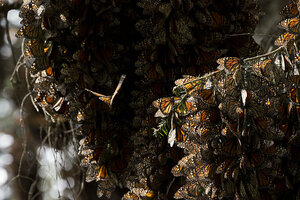Mexico’s monarch butterfly population makes a comeback. What happened?
An estimated 140 million monarch butterflies spent the winter in Mexico this year, a significant increase from last year. What conservation efforts went into this progress?

A kaleidoscope of Monarch butterflies cling to tree branches, in the Piedra Herrada sanctuary, near Valle de Bravo, Mexico in January 2015. This year, Monarch butterflies have made a big comeback in their wintering grounds in Mexico, after suffering serious declines, investigators said Friday, Feb. 26, 2016.
(AP Photo/Rebecca Blackwell, File)
Millions of monarch butterflies settled in Mexico for the winter this year. Forming a 10-acre carpet of black-and-orange striped winged insects in their wintering grounds, this year's migration represents a significant uptick in numbers for the majestic butterflies.
Because the monarch butterflies cluster on trees by the thousand, lepidopterists keep count of the insects by the area they cover. This winter saw a the butterflies blanket an area more than 3.5 times greater than the previous season, which saw 2.8 acres of butterflies. This is also up from the record low of 1.66 acres in 2013.
"It is time for celebration because we see the beginning of success," Dan Ashe, the director of the US Fish and Wildlife Service told the Associated Press. "But our task now is to continue building on that success."
Although this winter's count shows monarch butterflies are rebounding, there are still significantly fewer than just two decades ago. Monarchs peaked in 1996, coating over 44 acres of their Mexican wintering grounds.
"The increase is certainly great news, but the bottom line is that monarchs must reach a much larger population size to be resilient to ever-increasing threats," said Tierra Curry, a senior scientist at the Washington, D.C.-based Center for Biological Diversity.
Efforts to increase those numbers have focused on a variety of threats from habitat loss to harmful pesticides.
Mexico has seen an uptick in illegal logging in the monarchs' wintering areas. The butterflies need the trees to create a canopy to protect the clumps of insects from winter chills.
The reserve area in Mexico where they migrate to annually lost more than 22 acres from its buffer zone in 2015 alone. Officials have been cracking down on that activity and have arrested some illegal loggers.
But the responsibility doesn't just fall to Mexico. Monarchs migrate some 3,400 miles from the United States and Canada for the winter.
As Juan Bezaury, the Mexico country representative for The Nature Conservancy, told The Christian Science Monitor's Whitney Eulich last year, "It’s a species that needs all three North American nations cooperating to preserve this important natural phenomenon."
Last year, President Barack Obama instituted a plan to create a sort of butterfly corridor to support the insects' migration.
One challenge monarchs have faced on their journey is dwindling milkweed, among other nectar-producing plants. The butterflies need the plants to eat and reproduce. So the Obama administration has been working to plant and protect milkweed from herbicides and mowing.
The efforts have already expanded areas of milkweed by about 250,000 acres.
While these international efforts have already seen progress in restoring the butterflies' habitat, the Center for Biological Diversity was hesitant to celebrate just yet. The center pointed out in a statement that "the population was expected to be up this winter due to favorable summer weather conditions in the monarch's U.S. breeding areas."
This report contains material from the Associated Press.

